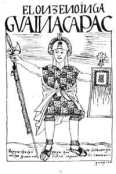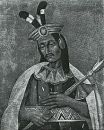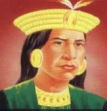Hello! This is part eight of a multi-part series on the Inca Empire and the Conquistadors. If you want some background, the introduction to this series is right here, and part seven is here. Or, I mean, start at part 8 if you want. It’s a free country.
With Almagro headed to Chile, Pizarro overseeing the construction of Lima, and Hernando Pizarro still in Spain, the governance of Cuzco and the oversight of Manco Inca was left to Juan and Gonzalo Pizarro.
This did not go well. Due to his hotheaded exploits, Juan Pizarro had a reputation as a fierce, brave and cruel soldier, someone unstoppable on the field of battle. But it was his brother Gonzalo who was the most trouble. Charming, cruel and a womanizer through and through, Gonzalo and his appetite for gold, silver and women quickly trampled over the slight veneer of modesty Pizarro had afforded the Inca nobles. The two younger Pizarro brothers were completely incapable or unwilling of controlling themselves, and they quickly descended upon the Inca empire with a ferocity that shocked Manco Inca.
Up to that point, Pizarro had shown a relatively deft hand in dealing with the Incas. While perfectly willing to take cruel and brutal actions, he was also careful to show native leaders the benefits of collaboration. When he caught his men torturing a native chief who they suspected had ordered an attack, Pizarro had stopped the torture and informed the chief that he was sure the chief had nothing to do with the attack, apologizing for his treatment and offering great friendship as long as the chief cooperated. He also made it clear that when he did find the perpetrator, that man would suffer unbearably before he died. Magically, the attacks stopped.
Juan and Gonzalo showed none of Pizarro or Hernando’s diplomatic touch. Juan and Gonzalo’s demands began with gold. As the conquistadors rampaged their way around the Peruvian countryside, they would frequently capture local chiefs and torture them for information about caches of silver or gold. If the unfortunate chiefs did not answer immediately, or did not offer enough gold to sate Spanish appetites, they were tortured until they revealed more. If they simply did not know of any gold, they would be tortured until they died, or the Spanish grew bored and let them go.

The younger Pizarro brothers extended these interrogations to Manco and his closest supporters, asking at first politely, and then more and more forcefully where his hidden gold was. Manco at first offered the locations of several hidden treasures, but these did nothing to cease the Spaniards’ requests. The more gold he offered them, the more they asked for, and the demands escalated from impertinent to rude to downright insulting. Manco was undoubtedly also hearing reports from his men across the countryside how chiefs and leaders had taken to hiding whenever the Spanish passed by, and Spaniards tearing apart entire villages in search of gold.
Of more concern, however, was the Spanish attitude towards Inca women. Throughout their time in the Inca Empire the Spaniards had seized Inca women to be their concubines, preferring temple virgins and women of royal blood for greater beauty and nobility. While Manco Inca and his followers disliked this behavior, for the most part they did not speak out against it, as the women the Spaniards had been taking were unmarried daughters, or had been the camp followers of Atahualpa or his generals. The Spaniards soon turned their eyes, though, on the wives of their “allies.”
Led by Juan and Gonzalo, the conquistadors took whatever women they pleased, including the wives of Manco’s closest supporters. When an enraged Inca general demanded the Spaniards stop this behavior, Gonzalo Pizarro cheerfully threatened to cut him in half on the spot. Manco Inca and his men soon began to realize how little power they actually had, and how little the Pizarro brothers cared for them.
As bad as these indignities were, worse was to come for Manco Inca. His wife and queen (or coya), Cura Ocllo, was a woman of amazing beauty and grace, much admired by both the Incas and the Spaniards. She was his sister, following the Inca tradition, and her children would have the purest royal blood and would be the leaders of the Inca Empire. She was, like her husband Manco Inca, almost a god in the eyes of the Inca people. Gonzalo Pizarro saw her and immediately declared that he wanted her, and demanded that Manco Inca give him his wife immediately.

Horrified, Manco Inca tried to distract Gonzalo Pizzarro. First he sent Gonzalo and his men a mountain of silver. Gonzalo laughed and said “this is all very good, but where is the coya?” Then Manco Inca sent Gonzalo several gorgeous Inca women. Gonzalo began to get angry, claiming that he was losing patience. Finally Manco Inca sent Gonzalo his cousin, who had been dressed up to resemble Cura Ocllo. Gonzalo was thrilled, but he eventually discovered the deception. Abandoning the double, Gonzalo found the real Cura Ocllo and roughly dragged her to his house.
With his wife seized from him, and his throne so clearly revealed as a farce, Manco began quietly planning a rebellion.
Dates
c. 1200 Kingdom of Cuzco is founded
1438-1471 Reign of Pachachuti
1471-1493 Reign of Tupac Inca
1492 Columbus discovers the Americas
1493-1527 Reign of Huayna Capac
1526 Pizarro and his thirteen men discover the Inca city of Tumbez
1527 Huayna Capac dies of smallpox brought by the Europeans
1527-1531 Civil war between Atahualpa Inca and Huascar
1531 Pizarro’s conquering expedition to Peru, Pizarro captures Atahualpa Inca, Atahualpa executes his brother Huascar
1533 Pizarro executes Atahualpa Inca and installs Manco Inca as the new Inca
1535 Pizarro founds the city of Lima
Characters
Incas

Huayna Capac – Emperor of the Incas [Died of plague in 1527]

Huascar – Son of Huayna Capac and the heir to the throne [Executed by Atahualpa in 1531]

Atahualpa – Brother of Huascar and rival for the throne, emperor of the Incas [Executed by Pizarro in 1533]
 Manco Inca – Younger brother of Atahualpa and Huascar, emperor of the Incas
Manco Inca – Younger brother of Atahualpa and Huascar, emperor of the Incas
The Pizarros
 Francisco Pizarro – Oldest of the brothers and mastermind of the expedition. A talented leader of men and a good strategist
Francisco Pizarro – Oldest of the brothers and mastermind of the expedition. A talented leader of men and a good strategist
Hernando Pizarro – Second of the brothers; a canny and calculating tactician
Gonzalo Pizarro – Third brother; charming womanizer with a vicious cruel streak
Juan Pizarro – Youngest of the brothers and a powerful, impetuous soldier
Almagristas
 Diego Almagro – Partner with Pizarro and one of his oldest friends, a hardened veteran of many battles ready to strike it rich [Leaves Peru to conquer Chile in 1535]
Diego Almagro – Partner with Pizarro and one of his oldest friends, a hardened veteran of many battles ready to strike it rich [Leaves Peru to conquer Chile in 1535]
Diego Almagro II – Almagro’s son, a hot-headed young soldier [Accompanies his father to conquer Chile in 1535]
Royalists
 Cristobal Vaca de Castro – Viceroy of Peru, a flexible and adaptable man
Cristobal Vaca de Castro – Viceroy of Peru, a flexible and adaptable man
 Blasco Nunez Vela – Viceroy of Peru, grating and brusque administrator
Blasco Nunez Vela – Viceroy of Peru, grating and brusque administrator
 Pedro de la Gasca – Viceroy of Peru, a clever politician and adept manipulator
Pedro de la Gasca – Viceroy of Peru, a clever politician and adept manipulator
One thought on “Chapter 8: Seeds of Rebellion”